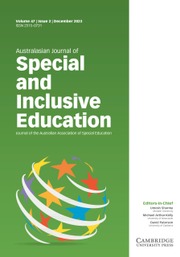Article contents
The Subjective Norm and Attitudes of Preservice Teachers Toward Pupils With a Disability: An Experiment Based on the Cognitive Dissonance Theory
Published online by Cambridge University Press: 09 November 2020
Abstract
Both the attitude of the preservice teacher and the subjective norm in the teacher-training program play a crucial role in the process towards inclusive education (Donnelly & Watkins, 2011). However, little research has been done on influencing the attitudes of preservice teachers via the subjective norm. Two studies were carried out using a pre- and post-test with students of the teacher-training program (N = 24, N = 34) who were divided into 2 experimental conditions in which the subjective norm was manipulated in the form of positive or negative discourse towards pupils with disabilities. Attitudes were assessed by the Chedoke-McMaster Attitudes Towards Children With Disabilities (CATCH) Scale (Rosenbaum, Armstrong, & King, 1986). Results show that we can cautiously assume that the subjective norm has an influence on the attitudes of the preservice teachers and that cognitive dissonance was experienced in which preservice teachers changed their own attitudes as a function of the subjective norm. The results of this study are therefore a plea for teacher education programs to not only focus on strong inclusive curricula but also pay sufficient attention to the inclusive mindset of teacher educators as role models for preservice teachers.
- Type
- Original Articles
- Information
- Australasian Journal of Special and Inclusive Education , Volume 45 , Issue 1 , July 2021 , pp. 49 - 61
- Copyright
- © The Author(s) 2020
Footnotes
This manuscript was accepted under the Editorship of Michael Arthur-Kelly.
References
- 2
- Cited by


